Friends having been persuaded to invest in the Honduran island of Roatan, south of Cuba, invited the Brumbys to visit in March 2017. Having little knowledge of the Central American region, save for Costa Rica and Puerto Rico, if that counts, we took them up and flew United Airlines London-Houston where one must overnight at the massive airport before taking another 2-hour island flight next morning. On arrival, the airport carpark gave up a prize immediately, with 3 of the International Mission (also titled elsewhere Aid/Non-Government Org.) MI plates. Brown rim and lettering rather than the red suggested in the guides. They must be batch-coded, as there would not be 4463 such vehicles, even in Honduras! MI 4463
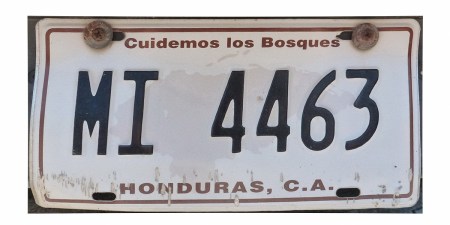
INTERRUPTION:
Though I have always favoured pictures of plates mounted naturally on their vehicles, I find that photographing plates in countries which use small detail in their plates is seldom successful when reviewing them later. Nowadays, aided by the free-use digital cameras and phones, we can take both distance AND close-up shots.
I used to be able to then create a ‘comp’ – a composite picture for display, using Photoshop – but I have forgotten how to do it!
This is an comp. example, from a 1996 visit to an Egyptian fire station

Therefore, the Honduran photos shown here tend to be portraits, so that the reader can see the detail.
HONDURAS CONTINUED:
Another plate type first seen at the airport, was this National Government plate using an ‘N’ prefix. N 11905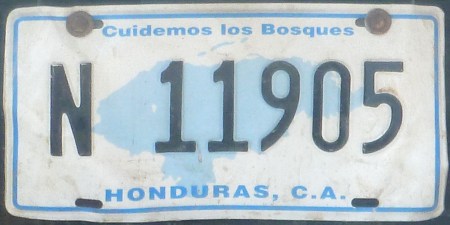
These National plates use the colours of the current private vehicles issue and are used by the regular police and other state offices. N 11905 is an undercover police ‘ute’ (or pick-up truck), photographed from the safety of our hire-car, as they had more guns than we..
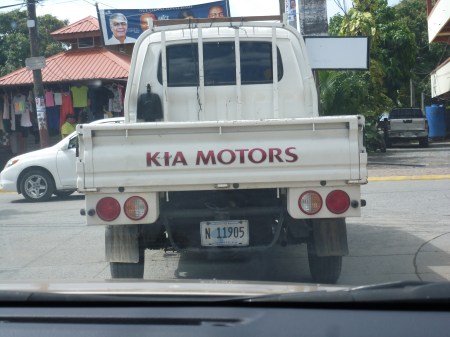
The alpha system uses two forms of the letter ‘N’ and perhaps Honduras could be the only country to use Ñ….
PDÑ 9676 has the Private vehicle prefix P and the Dx serial was current during our visit, changing to PEA just as we left, pursued by swarms of sandflies and mosquitos, two of the islands’ most successful breeding fauna, alongside the poor but jolly villagers.

Duty-Free Imports
There are two colours of PP plates, which were thought to be for rental cars – but they use normal plates. I was told by a Thpanish-thpeaking local that the PP abbreviates ‘Placa Pimiente’ or Temporary Plate, and later, by an American whose car carried a set of them, that, to encourage retirement settlers from US and Canada to Honduras, their household equipment and cars may be brought in free of import duties, providing they are not sold within five years.
Costa Rica has a similar privilege plate for retirees.
Our esteemed Editor, Señor Barragan, who knows a good bit of Thpanish tells me there is no such word as Pimiente – so it seems that my first source spoke with forked tongue.
Anyway, most PPs are all-red but a few light pick-ups (utes) had black lettering. Why?
A new discovery was a trailer system, with a leading ‘R’ as usua;, for Remorque or similar, and a serial letter. They are uncommon, yet they have reached C as a serial. Trailer R C 1429, adjuring all to ‘Protect our Forests’. The English word ‘bosky’ is a relative of this Latinate word Bosques….
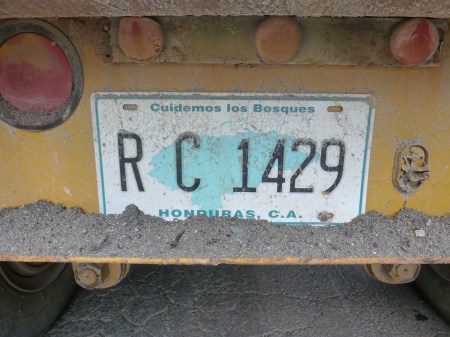
and trailer R A 8536
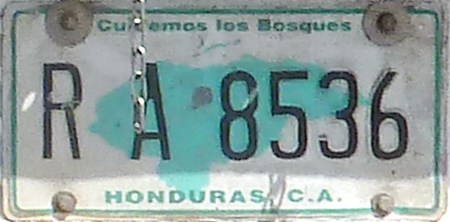
Motorcycles are as expected, prefixed M …

The Fire Brigade seems to have freedom of choice about what it displays!



Ambulances enjoy a similar freedom. Same plate front and back.

A lengthy chase following a high-speed turn-round enabled the photo-capture of an unknown military plate type, Repubblica Honduras Fuerzas Navales, as I judge it to mean, and we may rely on the Placamundi contingent to bring accuracy where there is only inspired guesswork.

Several small cars carried the plate below and were hired to tourists. It’s not exactly a plate, is it?

A special police group travel with blue plates, unlike any others and are tricky to photograph, for reasons you will understand. This is as close as my survival instinct permitted me to get to white on blue, stencilled UD 11-001….
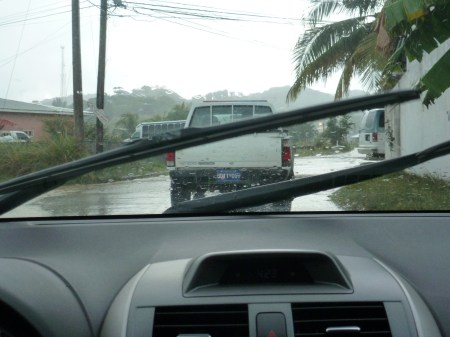
….from which my editing software gleans this:
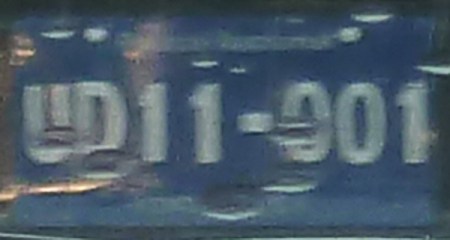
The only non-Honduran plates on the island were from Guatemala. It seems that there is paid work for GCA workers if they come to the island. The authorities are still issuing 2004-dated plates!

This GCA ute was dumped. Its P947 DWS plates were secured by self-tapping screws and are no longer attached. A brand-new ute (still 2004) P767 GJJ is seen below.

A couple of odd US plates varied the diet:
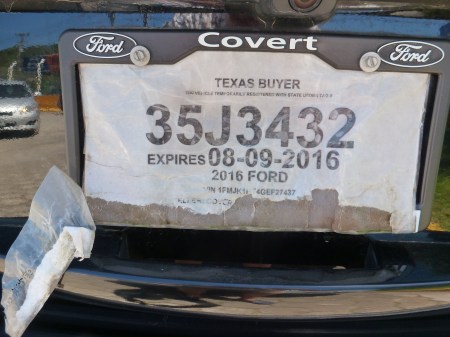

I suspect the driver of the Texas vehicle was laid low by the sandflies, the heat and the ghastly food of the island and was issued a handicapped plate by his hospital back home. Odd thing is, he went back to Honduras for more…… We won’t.
Victor Brumby, April 2017
QUIZ
For three weeks I have been dismantling the pages of Karel Stoel’s German albums and the period 1895-1945 is at last complete. A plate I cannot identify presents your chance to show us your skill as a xeno-autonumerologist: D 7090
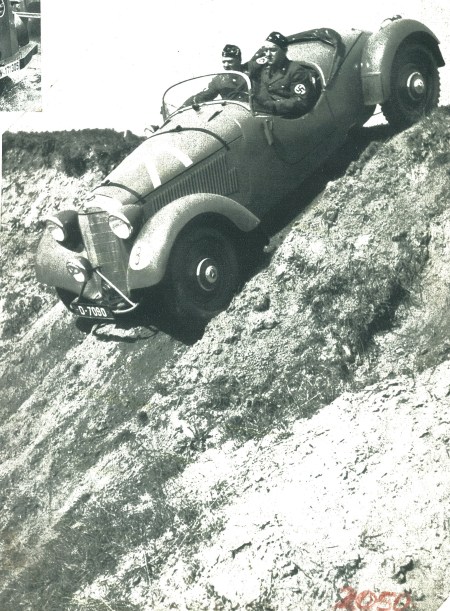
~~~~~~~~~~~~~~~~~~~~~~~~~~
More early German shots will appear in the next posts plus some of the Protectorates seized from the surrounding countries when Adolf got the bit between his teeth.
Here are two cars of senior government personnel, parked outside a great meeting hall in Vienna some time during 39-45. Early vanity plates! Nd 1 and W 101 are from Lower Austria and Vienna Protectorate… Vienna/Wien used white plates during the occupation.
Less exotic IIB 57022 is from Upper Bavaria (Oberbayern). How about identifying the three cars?

Now get back to work.






Could D-7090 be 1930-38 Austria (D for Salzburg)? But did those Austrian plates ever have a hyphen?
Usually they didn’t. Might it be Drente, Netherlands? After the German occupation, of course.
Austrian plaTes did not have a coat of arms until 1938, but a hyphen. D stands for Salzburg.
eu146 – I have studied the many Austrian plate photos of the 1930-40s and not a single one shows a hyphen, which you believe they should.
It is because D-7090 shows a hyphen that we threw the puzzle out for opinions, but we aren’t any closer yet to identifying the plate. If you should have any images of hyphened Austrian plates, would you share them by posting here on the BloG? Thanks.
Oh – eu146 – and any pics you have of Austrian plates showing coats of arms – our archive has none of them either, until the current white plates were introduced. Vic B
eu0146 – Would you have any pics of pre-war Austrian plates showing a hyphen, please? We can’t find any.
The Dutch provincial license plate D-7090 belonged to Lambertus de Vries, who lived in Kleindijk, Drente. The problem is that this plate did not belong to a car, but to a person. I’m still looking for evidence that sir de Vries owned a Mercedes as shown on the photo.
I think I’ve found something. If you take a real good look at the picture, you will see that there is an additional picture of a license plate in the left upper corner. This is the car’s rear license plate W-171305. The book: “Registration Plates of the World”, this is what someone told me, says that those plates belonged to embassies in Austria. My guess is that this could have been the embassy of Germany.
Mark (1134) the W-171305 you have perceived is just a part of the scan of the page and belongs to a separate photo in the Stoel album. I had to show that photo-corner in order to display the shot of D-7090.
We STILL don’t have a definitive answer to the identification of the Mercedes cross-country sportscar! (Though the model is listed in the 1930s M-B historic models list.)
And I thought I had a breakthrough. Perhaps this information will help. The uniforms shown in the picture were not used during the Second World War in the Netherlands. These were used in Austria in 1938.